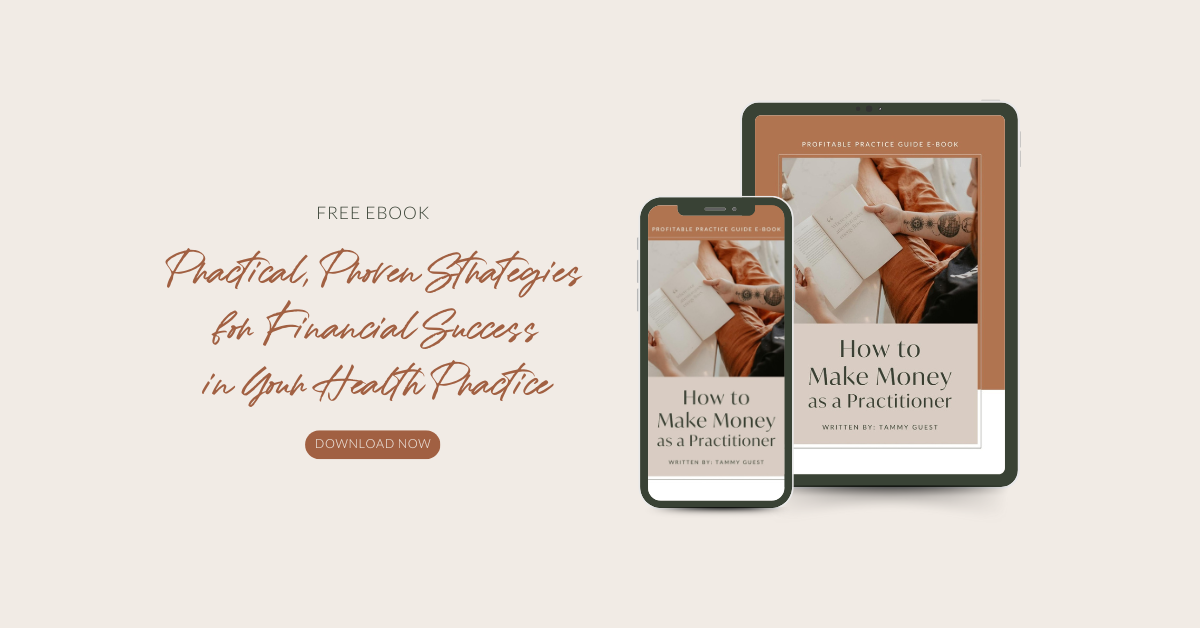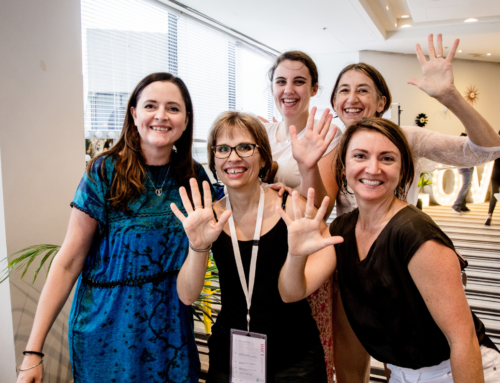In this episode of the Natupreneur Movement podcast I’m chatting with nutritionist, health writer and wellness speaker, Sam Gemmell.
Sam shares how her journey with thyroid cancer not only spurred her onto becoming a nutritionist, but it also influenced her business model to truly have a business that takes care of her. She also incorporated her genius at marketing into her business and shares her 5 best tips to attract ideal clients into your business!
Tune in or read the transcript below.
T: Hey everyone! Welcome to another episode of the Natupreneur Movement!
I, as usual, am very excited to talk to our guest today. She is an integral part of the Natupreneur Hub! I got the pleasure of meeting her in real life at NatEx in 2019 and I’m super pumped that she’s going to be at NatEx 2020!
Sam is an extraordinary human who is ever generous with her knowledge and background as not only a nutritionist but as a marketer. Hey, Sam, nice to speak to you!
S: Lovely to be here, Tammy. So excited!
T: I love talking to people who are just as passionate as me about the business side of being a practitioner as well as the side of being a total human as a practitioner. I want to find out a bit more about how your journey to becoming a nutritionist began.
Sam’s Journey Through Thyroid Cancer
S: My first journey to being a nutritionist started when I was 19. I had been really rundown for quite a while and I knew that I had a thyroid condition that was diagnosed when I was 16. But this was before there was really much knowledge about thyroid conditions and before it was cool to have a thyroid condition. So the doctors pretty much just told me to wait for my thyroid to destroy itself and then they would do something about it.
One day, I just really wasn’t feeling well. I wanted to take a day off work, went to an after-hours GP to get a medical certificate, and she noticed that my thyroid was really swollen. After a little bit of following up with my GP and getting scans and stuff, it turned out that I actually had thyroid cancer! I had apparently had it for years and it just was running in the background.
I did the usual – I got the surgery, I got the radioactive iodine. But of course, because this was before anyone really understood much about the thyroid, all the doctors just kind of went, “Okay, you’ve had your treatment, you’ve had your surgery. We’ll see you in a year or two for follow up, off you go.”
But my body was not, “off you go.” I was run down. I had almost no immune system left. It wasn’t until I caught a triple infection – I had three infections back to back over a period of 10 days – that I realised I had to do something about it. Being the geek that I am, I started doing some research and I started learning a bit about food as medicine. And I fell in love with it!
Discovering Naturopathy
It just so happened that I had a magical day off work on a weekend, which never happened back then because I worked in retail. I went to an open day at Endeavour and walked out a student.
T: Oh my goodness. So you just made a decision right there and then. You were like, “Yep! This is the thing for me.”
S: The lecturer turned to me at the open day and said, “Why haven’t you already signed up for this? You’re obviously so passionate about it.”
I said, “I only found out it was a thing six weeks ago!”
T: Yeah. Wow. That is awesome. So you were working in retail, what was happening then? Like, was there anything about that that you really loved?
What I Learnt From Working In Retail
S: Not initially, I’ve always been in retail ever since I was legally allowed to work. It was just a job that kept me going. When I got out of high school, I didn’t really know what I wanted to do. But I did have an older sister who got pushed into university and started three degrees and didn’t end up finishing any of them.
So I knew I didn’t want to dive in until I was 100% sure that it was something that I wanted to do with my life and something I wanted to spend my money on.
That being said, it has always been said, from a very young age, that I could sell ice to the Eskimos. So retail was a pretty natural place for me to coast until I did find what I wanted to do.
T: One of my receptionists at the multi-modality Clinic I used to own, had an entire background in retail. This was just as I started learning about business, I was just gobsmacked at what is actually absorbed when you’re living and breathing marketing.
Retail IS Marketing
Because retail IS marketing. It’s how you are selling things to people, how you’re helping them, how you’re speaking in the customer’s language, understanding the transaction of money, and the transformation that you can have with giving somebody what they want. And I only started seeing that because she was just extraordinary at that aspect of taking care of our clients.
What did you learn from retail that you now use in your everyday life?
S: Towards the end of my retail life, I was working a lot with Pet Barn. Many of you may know I’m absolutely obsessed with animals and I’m a massive dog lover. They were really amazing in the way that they did their training. It’s actually written into the contracts at Pet Barn that you have to greet every single person and every single pet that walks into the door.
Find Out What People Want Help With In The First Place
So from the very start, you feel like your focus is 100% on them and how you can help them. They’re also really big on finding out what it is that the people actually want in the first place. Why did they come into the store that day? We’re happy to just let you browse if you want to browse, but did you come in to solve a specific problem that you’re needing help with?
I think this is something that a lot of people skip – actually finding out what people want help with, in the first place.
T: Absolutely. That’s a key one. Because often when we get our ‘business brain’ on, we just start to think about ourselves, our own words, all that kind of stuff. Like a pendulum swing, it does tend to swing back, and then get into it. But that’s a big missing piece.
As a practitioner, we can often see the underlying cause. But that’s not the problem they came in for. They just want the little surface thing to disappear. And you’re just all of a sudden talking about something that they didn’t even know was a problem.
S: Absolutely. I used to have a student naturopath friend. We would go to a cafe, just watch people and spot their health issues just by looking at them. We could spot thyroid goitres and the way they were holding their fat stores.
But just because you can see it doesn’t mean they can. Most people just are tired or they’re not losing weight or they are looking for ways to boost their energy. It’s usually coming back to really simple things across most people. Very few people actually know what is going on underneath.
Working In Nutrition AND Marketing
T: Yeah, absolutely. So it didn’t stop there for you around nutrition. When I met you in real life, you kind of had your feet in both those camps of nutrition as well as this aspect that was growing in you around marketing. So what’s happened this year for you?
S: What hasn’t happened this year? This year has been a bit of a pivot year, as I’ve been calling it.
At the start of the year, I was still paddling a little bit in nutrition and I still have small aspects that I incorporate. I still do talks for corporate and with Sclera down in Victoria because I have a very close relationship with them.
Adding Marketing Support To Her Business
But the majority of my work at the moment is around content and marketing. It’s really been the last couple of months that I’ve embraced the marketing side of things. I sort of hit this stuck point around August or September where I just wasn’t loving what I was doing. All I was doing was sitting down and writing, and sitting down and writing. Although I love writing, I was losing that aspect of being able to interact with people and inspire them and help them find solutions to their problem.
So I decided to open up my niche a little bit instead of narrowing it down, and included marketing and marketing support. And ever since it’s been going crazy!
T: Awesome! So I know that you are an exceptional writer and you the ghostwriter of many hidden blog posts. And your name is on blog posts, as well. But this marketing aspect has been such a huge game-changer.
It was for me in my practice, too, to start to understand that I’m not going to be the best at absolutely every different job that being a practitioner in business is all about. As soon as I found somebody that I resonated with that had even a remote connection with health, it made things so much easier to speak to them about what my business actually needed. What I needed to do to get more clients in the door who were my favourite ideal clients, rather than the ones who were exhausting me or that were better suited to a different practitioner.
Top 5 Tips To Attract Ideal Clients
What would you say? I’m a top-five type of girl. So what are your top five tips for what it takes to actually get somebody through the door that is going to be an ideal client?
S: Sure. I’ll count this on my fingers, so I don’t lose track.
Tip #1: Know Who You Want To Be Seeing
So number one would be to know who you actually want to be seeing in the first place gold. I know I talk a lot about niching and people get really scared. But to me, niche is simply the people that you want to have coming in the door every day and they’re going to light you up. You’re going to feel amazing when you help them transform their health and their lives.
T: And they’re also going to feel amazing because you’re the right person for them. Because you’re passionate about their particular way of being and the particular condition.
S: Absolutely. It makes such a big difference to everyone. There’s no benefit to you seeing people who aren’t a good match for you because both teams are going to lose.
Tip #2: Meet Them Where They’re At
So that’s number one because if you don’t know that, then you can’t move on to step two, which is to make them where they’re at. This is what we were talking about before where you think you know their problem, but they have a completely different view on their problem. Really understanding what it is that they want help with and tailoring your content and your marketing to address that.
T: I’ve got a little story with that. One of my old clients was an elderly gentleman. All he wanted to do was get rid of this interesting spot on the back of his hand. It had been there forever. And he had been suggested that a naturopath would be able to help with that.
When I did his full case, he had been getting migraines all his life, he had constipation, he had detoxification issues that weren’t addressed over a long term of chemical exposure. He had all of these things going on. So I addressed all of those things. After he had been with me for four months, he sleeping better than he ever had done and forgotten that he had migraines, they were so rare. And he was pooing like a champion.
But every single time he came in, he would point to the spot on the back of his hand and ask why he had spent so much money with me but the dot hadn’t disappeared! The lesson here is that meeting somebody, where they’re at, is more important than all the things you think you’re going to be helping them with. Because they aren’t going to feel like their version of health or their version of what they wanted from this situation is being met until you actually address that.
S: Absolutely. You can address where they’re at first and then work long term with them because then you’ve built that trust with them.
Tip #3: Get In Front Of Them In The First Place
Number three is to actually get in front of them in the first place. Get visible. Where are these people hanging out? How can you get them to see you there? You can’t just sit in an office with a shingle, anymore.
T: So if I just go and run one little talk, do what’s your experience of that? Do you think that I’m going to be in front of enough eyes to be able to make a conversion into a client?
S: The conversion rate for clients these days can be as low as 1%. I always say that to get one client, you need to be in front of maybe 10 to 20 people if it’s an in-person talk, or as high as 100-200 people if it’s something online like a webinar. You need to get in front of many eyes as possible.
T: I agree completely! Yes! Did you hear that people? If you’re listening, I’m going to get my ranty pants on.
In general, cold is 1-3%, warm is about 10%. Just like Sam just said, if you’ve got 10 people in a room, possibly one person will want to continue to come to see you. If you’ve got 100 eyes on your webinar, then one of those might want to come to see you.
So when you’re thinking about if you’ve done enough and been in front of enough eyes this week and decide to go study some extra pathophysiology, more about a niche that you’re not in, or more about the human body – if you spend that same amount of time getting eyes on your work, eyes on your stuff, you’d then be making the conversions and getting more ideal clients in the door.
Tip #4: Be Consistent
S: Absolutely. And that ties into number four, which is to be consistent with it. The people who come to me all the time, the first words out of their mouths are, “I’ve seen you everywhere, Sam. You are everywhere all the time. I see what you do and that’s why I wanted to work with you.” They know that’s what they need to be doing and they need to figure out how to do it for themselves.
T: We all have ebbs and flows. I mean, we all have days where we don’t want to show up and weeks, even, where we want to hide in a cave. 96% of the Natupreneur audience is female. So, we ALL have that week where we just want to be in the cave.
But there are ways and means to be consistent and persistent that then allows you to be top of mind. That was the first business term I’d ever been exposed to: TOM = top of mind. It’s only ever really stood out to me when I think about, “Who do I need to call for such and such? This person’s always talking about that.”
So I completely agree with that. Love it, love it.
S: And it’s so important to realise that consistency doesn’t mean consistent for a week or consistent for a month. It means being consistent across the board. It’s taken me six-plus months in a pretty large business group to become known as the health writer. I showed up, I kid you not, every single one of every single day of that six months to build that reputation.
T: Yes. It’s a long game and building any relationship is like that. And you are you building a relationship with a group of people.
Tip #5: Plan & Batch As Much As You Can
S: It’s perfect that you brought up the fact that sometimes we want to hide because that is my tip number five. Plan and batch as much as you can so that when you do have those days when you want to hide away, you can just copy and paste a tip across instead of having to make something up from fresh.
T: Absolutely, I love that one. So many people think, “Oh, I can’t make things up on the spot.” But when the Muse hits you and the ideas are flowing, that’s when you get them all in one big batch and you’re able to get them out. And that’s really important for people who have a chronic condition, health condition, or might be caring for family members or others.
I know that so many practitioners got into the caring field by caring for others. But we do have those days where we can’t necessarily show up in the moment. We do have those days when we can’t show up in the moment. But when we get those really good flowy days, batching is a great, great tip. Love it.
What Do You Love About Your Work?
The theme of NatEx is Love Your Work, Love Your Life, and Love Yourself. What else do you love about your work?
S: Well, I think that’s perfect because my work does allow me to love my life and to love myself. Because I get to take time to self-care when I do have a flare-up of my own health issues. I get to work from a comfy space with my puppy dog snoring on my feet. She’s actually sitting right behind me right now, snoring her head off.
T: I love that. Having a business doesn’t have to be the old school way that we might even have been taught in our qualification. It doesn’t have to be one-on-one in a brick-and-mortar space, being there nine to five, five days a week. It really is every other variety of that that has to meld with your lifestyle, your personality, the way you love to work, and how you can actually fill up your cup whilst being in business.
S: Absolutely. I feel like 2019 was a very introverted year for me. Even for myself being a natural introvert, I felt like a lot of my work was more in my own space. But it’s also given me the ability to pivot out of that when I felt that I needed to spend more time actually interacting with people. Quite naturally over the year, I prefer spending more time by myself in the winter when the weather just makes you want to sort of curl up in your PJs with a hot chocolate. But as the weather gets nicer, at least theoretically here in Melbourne, it means that I can spend more time doing one on one sessions with people.
T: That’s so cool. We all have so many different personality traits at different times of the year. To be able to build that into business makes your life so much more pleasurable.
Managing Burnout
Love yourself is an element that we’ve brought into NatEx 2020 and it’s mainly because I see so much burnout. I mean, I wrote a whole book on adrenal fatigue and burnout as an entrepreneur. And I see that it’s rampant. So I really want to open up the conversation about taking care of ourselves in a deeper way.
What’s something that you have done to take care of yourself when it comes to running your business and your life?
S: Most recently, it was actually taking time off from being visible and out there. I took two weeks, pretty much completely off social media, to look after myself and to recharge before I jumped into springtime. And I went back to absolute basics because a lot of the times when you are burning out that’s the stuff that slips up.
So I was drinking two litres of water a day, making sure I actually ate three meals a day instead of just forgetting to have lunch because I was too busy. I was closing down my laptop by 5pm and not getting back on it until at least 7am the next morning.
We often get so caught up in the knowledge that we have that we forget the basics when we do want to address an issue. Yet it’s often the things that we tell clients to start with.
T: That was one of my biggest ‘Aha!’ moments when I was in the midst of burnout. Everything that I was saying to my clients over and over again, I one hundred per cent needed to prescribe to myself.
S: We’re often our own worst examples.
T: And own teachers!
Remember To Take Your Own Advice!
S: Yes, absolutely. There’s a lesson to be learned. If you’re telling your clients the same thing over and over again, you do need to check-in and make sure that you’re practising it as well.
T: Absolutely! Oh my goodness, I could just keep talking to you all day, Sam. But I’m super excited that you’re coming to NatEx 2020. I can’t wait to see what you’re wearing to the XFactor Awards, as well.
S: Oh, yeah, gotta pick out the best dress out there
T: On the teal carpet! I’m really excited! And I’m so appreciative of you sharing your golden nuggets of wisdom. Thanks again, Sam. It’s been awesome.
S: Thanks for having me, Tammy.
Take Action
If you are listening and you want to know more about Sam, you can visit her website at www.samanthagemmell.com.
If you haven’t already, you need to join us over at the Natupreneur Hub because Sam is in there with consistent, persistent generosity sharing her tips all about how to get out there, attract ideal clients, and look after yourself.
Join Us At NatEx
Sam is just one of the amazing, inspirational connections you could make at NatEx 2020. Will you be there?









Leave A Comment